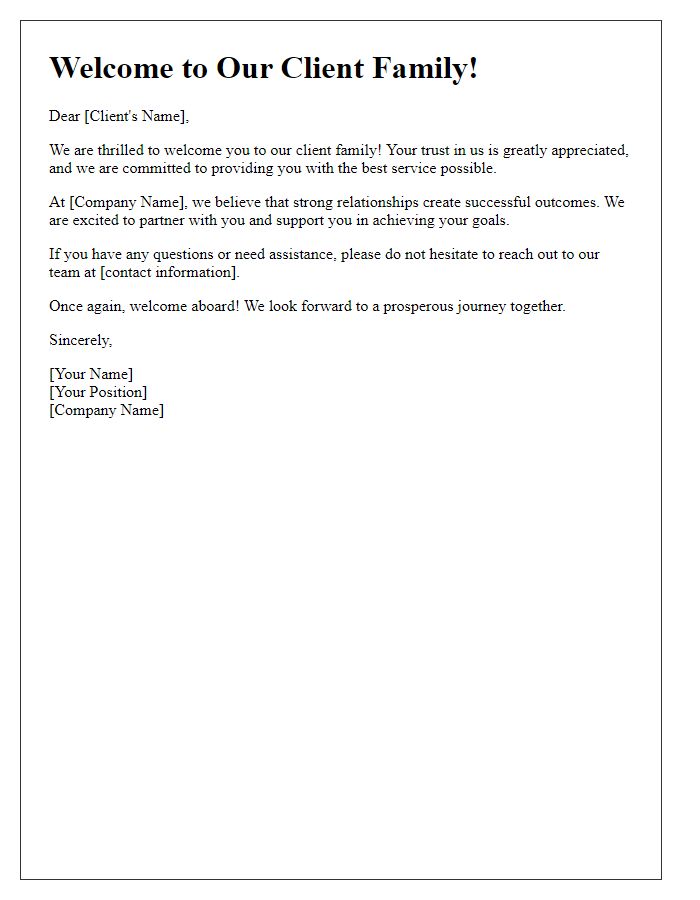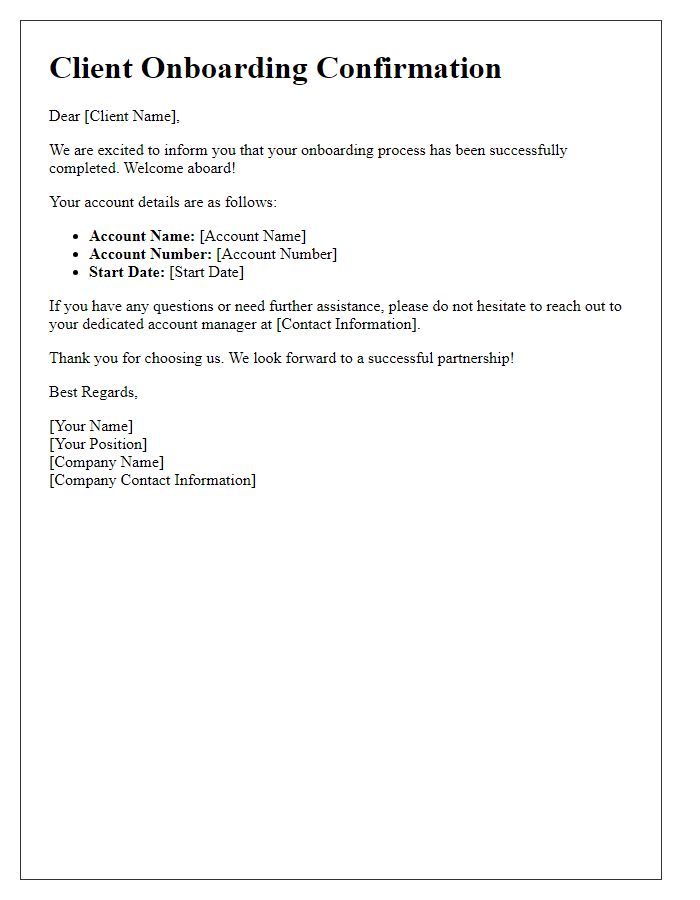Welcome aboard! We're thrilled to have you join our community and want to take a moment to express our gratitude for choosing us as your partner. Your onboarding marks the beginning of an exciting journey, and we're dedicated to ensuring you feel supported every step of the way. Curious to learn more about how we can assist you further? Read on to discover the next steps in your onboarding process!

Personalized greeting
Client onboarding plays a crucial role in establishing a productive relationship with new clients. Effective communication enhances their experience and sets clear expectations. A personalized greeting, tailored to the specific needs of the client, fosters a welcoming atmosphere. Including the client's name establishes a connection, while expressing appreciation for their choice underscores the value of their trust. Highlighting the onboarding process steps, such as initial meetings, training sessions, and resource allocations, ensures transparency. Special notes about the client's business goals or unique circumstances can reinforce commitment to their success. A warm and inviting tone encourages engagement and opens pathways for future interactions, essential for long-term collaboration and satisfaction.
Confirmation of received documentation
Upon receiving documentation for client onboarding, confirmation marks the initiation of professional engagement. This acknowledgment serves as an assurance that essential documents such as the Client Information Form and Agreement have been reviewed and processed. Timely submission of these documents typically occurs within the first week of engagement, allowing a seamless transition to the next steps in the onboarding process. The confirmation ensures clients that their information is secure and will be used to tailor services that meet specific needs. Additionally, this acknowledgment often includes a summary of expected timelines and further actions, fostering clarity and a focused approach to collaboration.
Overview of onboarding process
The client onboarding process begins with a series of structured steps designed to facilitate a smooth transition and establish a productive partnership. First, a detailed needs assessment is conducted through a comprehensive questionnaire, allowing for the identification of specific client goals and objectives. Next, an onboarding kickoff meeting is scheduled, where key stakeholders discuss timelines, expectations, and deliverables. During this phase, clients receive onboarding materials, including user guides and access instructions, tailored to their services. Training sessions follow, which may be conducted via webinars or one-on-one consultations, ensuring that clients are fully equipped to utilize our systems effectively. Throughout the process, regular feedback loops are established to address any concerns promptly, resulting in a tailored experience that fosters a strong client relationship. Finally, a formal review is conducted to assess the onboarding experience and solidify ongoing support mechanisms.
Point of contact information
Client onboarding involves a thorough initial engagement process, which establishes a clear point of contact for effective communication. A designated representative, often referred to as the Account Manager or Client Liaison, serves as the primary facilitator, ensuring clients feel supported and informed. This individual typically provides their direct phone number (such as +1-555-0123) and email address (like contact@companyname.com), allowing for seamless interactions. A detailed onboarding schedule, outlining key milestones over the first few weeks, may include introductory meetings and training sessions, setting expectations for productive collaboration. Proper acknowledgment of this point of contact is crucial to nurture a strong working relationship, ultimately leading to client satisfaction and retention.
Express gratitude and future engagement
Client onboarding represents a pivotal moment in a business relationship. Effective onboarding includes personalized communication, extensive orientation sessions, and streamlined access to resources. Expressing gratitude reinforces positive sentiment; acknowledging their trust boosts confidence. Future engagement strategies, such as regular check-ins, tailored follow-ups, and feedback mechanisms, enhance mutual understanding and pave the way for successful collaboration. Establishing clear expectations during onboarding ensures alignment and fosters a sense of partnership that can thrive over time.













Comments